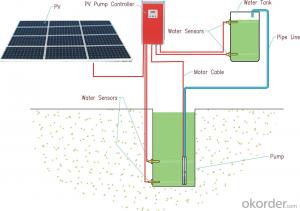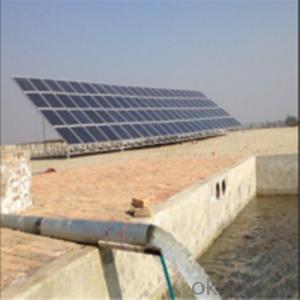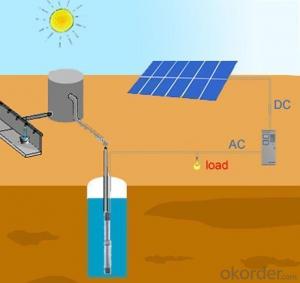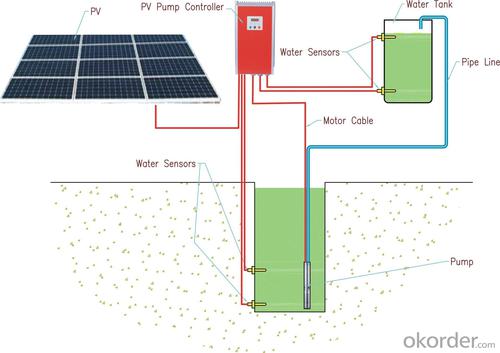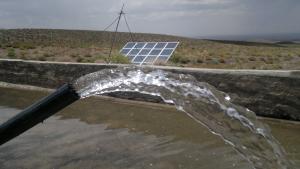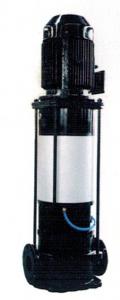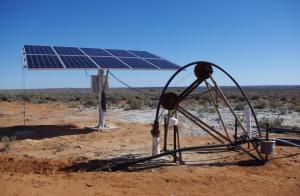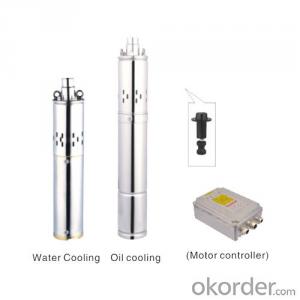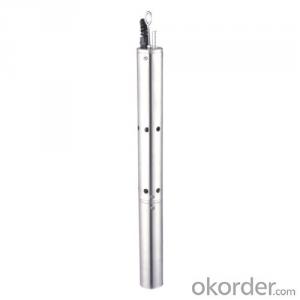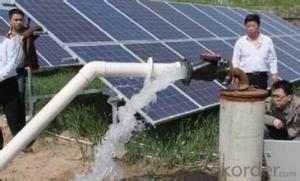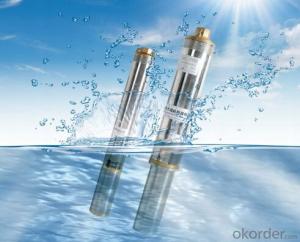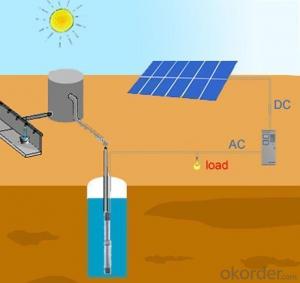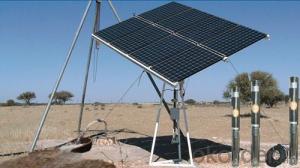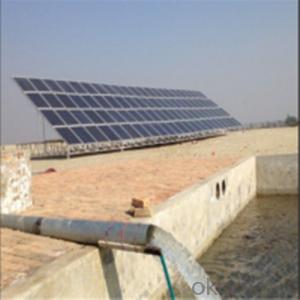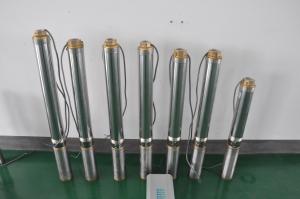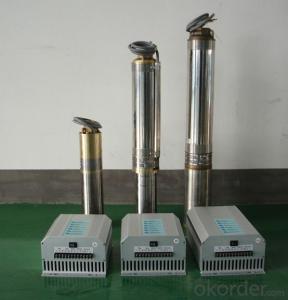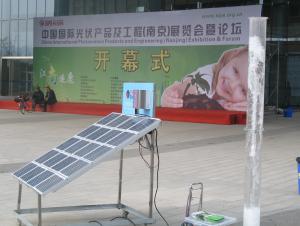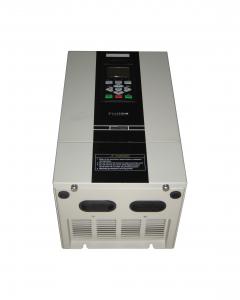Silicon Solar Pump - Battery Powered Water Pump Solar Panel Water Pumps
- Loading Port:
- Shanghai
- Payment Terms:
- TT OR LC
- Min Order Qty:
- 1 set
- Supply Capability:
- 1000 set/month
OKorder Service Pledge
OKorder Financial Service
You Might Also Like
Battery Powered Water Pump Solar Panel Water Pumps
Advanced Technology
Applications Innovation
The efficiency of DC brushless permanent magnet motor has been increased up to 25% in comparison with traditional asynchronous motor.
Technology Innovation
Stator and rotor are sealed by environment friendly casting resin.Motor insulation resistance can be hold higher than 300MΩfor more than 10 years, which consumedly increased the security and reliability of the submersible motor.
Structure Innovation
Casting resign technology processed stator and rotor as well as the water lubricated bearing make the submersible pump environment friendly.
Feature
High Efficiency & High Reliability
DC Brushless Permanent Magnet Motor
Minimum Maintenance, long Service Life
Environment Friendly Materials, Lubricated Without Oil
Automatic Control
Operate Automatically, No Need Watching
Maximum Power Point Tracking (MPPT)
Dry-run Protection
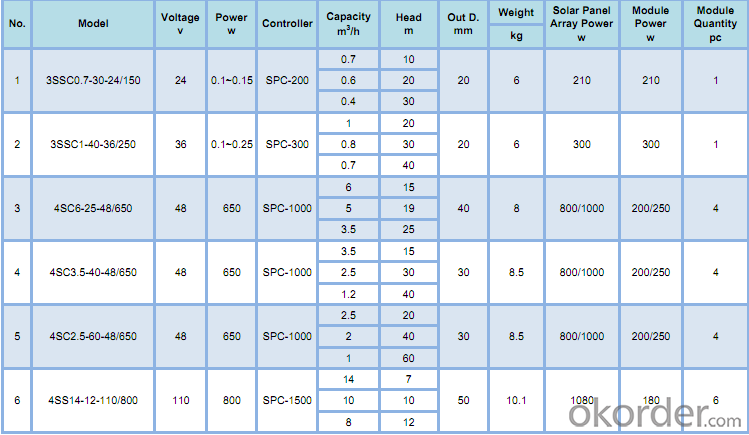
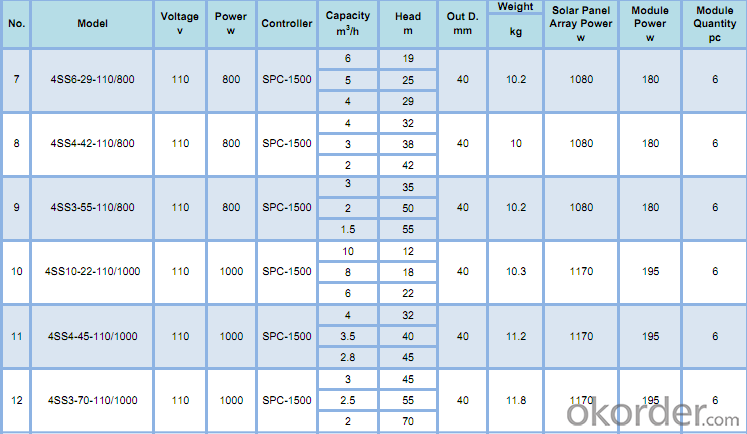
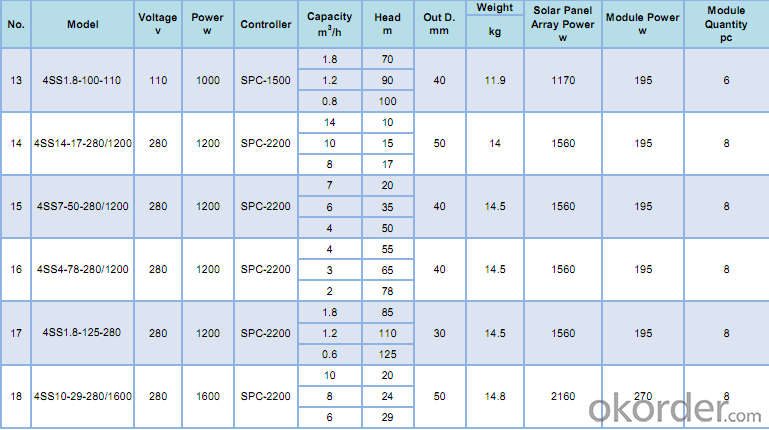
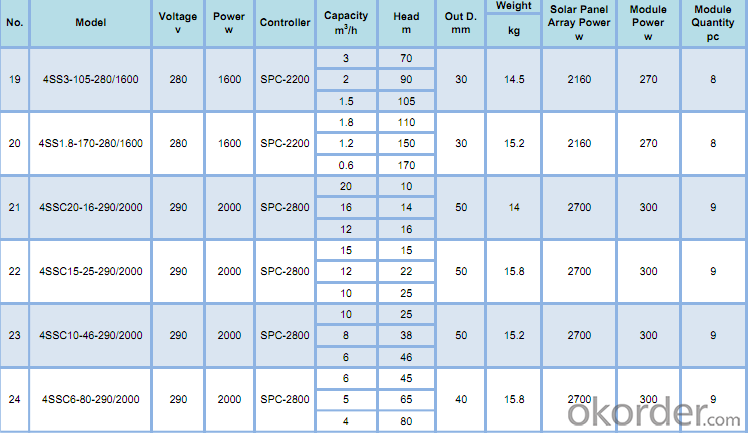
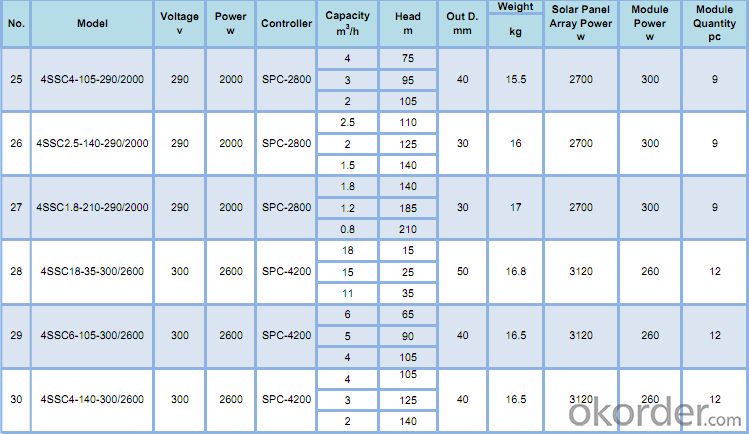
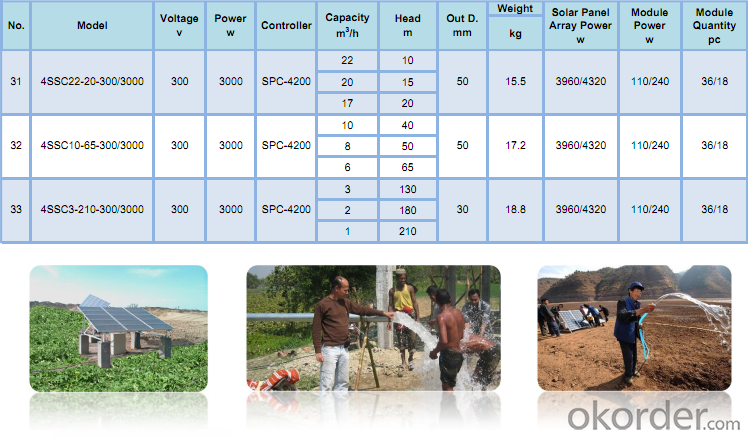
- Q: How does a solar pump help in reducing soil erosion?
- A solar pump helps in reducing soil erosion by providing a sustainable and reliable source of water for irrigation. By using solar energy to power the pump, there is no need for traditional fuel sources, which can contribute to pollution and environmental degradation. This enables farmers to efficiently water their crops, preventing soil from drying out and becoming susceptible to erosion. Additionally, the controlled and precise water distribution facilitated by solar pumps minimizes excessive runoff, which can wash away fertile topsoil and cause erosion.
- Q: Can a solar pump be used for industrial purposes?
- Industrial applications can indeed utilize solar pumps. These pumps are increasingly being employed in agriculture, manufacturing, mining, and water treatment. They operate on solar energy, which not only renders them eco-friendly but also cost-effective in the long run. Solar pumps boast high flow rates and pressures, making them well-suited for industrial tasks requiring water supply, irrigation, or fluid transfer. They can extract water from wells, rivers, lakes, or reservoirs, and can even be integrated into existing water systems or networks. The cost-saving potential is one of the key advantages of utilizing solar pumps for industrial purposes. As solar energy is a renewable resource, once the initial installation expenses are covered, ongoing operational costs are minimal. This renders solar pumps a dependable and cost-effective solution, especially in remote or off-grid locations where traditional electricity supply may be inaccessible or unaffordable. Moreover, solar pumps often come equipped with advanced technologies and monitoring systems that optimize their performance and ensure efficient water management. These pumps can be automated, enabling remote control and monitoring, which proves particularly valuable in industrial environments where continuous operation and precise water supply are critical. To summarize, a solar pump can indeed serve industrial purposes. Its ability to harness solar energy, cost-effectiveness, and reliability make it a sustainable and viable choice for industrial operations necessitating water supply, irrigation, or fluid transfer.
- Q: Can a solar pump be used for desalination processes?
- Yes, a solar pump can be used for desalination processes. A solar pump utilizes solar energy to power the pump, which can be used to extract water from sources such as wells, rivers, or oceans. In the case of desalination, the solar pump would be employed to draw seawater and transport it to the desalination plant. Desalination is the process of removing salt and other impurities from seawater to make it suitable for human consumption or irrigation purposes. Solar pumps are an ideal choice for desalination processes due to their use of renewable energy, making them cost-effective and environmentally friendly. Solar pumps can be utilized in various desalination techniques such as reverse osmosis (RO) or multi-stage flash (MSF) distillation. In the RO process, the solar pump is used to pressurize seawater through a semi-permeable membrane, separating the salt and other impurities from the water. In MSF distillation, the solar pump is employed to transport seawater to the heat exchangers where it is heated and evaporated, leaving behind the salt and other impurities. The use of solar pumps for desalination processes has several advantages. Firstly, solar energy is abundant and free, so it significantly reduces operational costs compared to traditional fuel-powered pumps. Solar pumps also require minimal maintenance and have a long lifespan, making them a reliable and sustainable option for desalination plants. Additionally, using solar pumps for desalination processes reduces reliance on fossil fuels, contributing to a reduction in greenhouse gas emissions and overall environmental impact. This aligns with the global efforts towards clean energy and sustainability. In conclusion, a solar pump can indeed be used for desalination processes, offering a cost-effective and environmentally friendly solution for extracting and treating seawater to make it suitable for various applications.
- Q: Can a solar pump be used for dewatering applications?
- Dewatering applications can indeed utilize a solar pump. These pumps are designed to prioritize energy efficiency and environmental friendliness, making them an excellent option for dewatering tasks. They have the capability to extract excessive water from various areas, including construction sites, basements, mines, and agricultural fields. By harnessing the power of the sun, solar pumps generate electricity, which then enables the removal of water from the desired location. Solar panels are typically integrated into these pumps to capture sunlight and convert it into usable energy. Moreover, they are user-friendly, operate silently, and require minimal maintenance. Furthermore, solar pumps can be equipped with backup batteries to store excess energy for cloudy days or nighttime use. In summary, solar pumps present a sustainable and cost-efficient solution for dewatering applications.
- Q: What is the typical installation process for a solar pump system?
- The typical installation process for a solar pump system involves several steps. Firstly, the site needs to be assessed to determine the optimal location for the solar panels and pump. Then, the solar panels are mounted on a suitable structure, such as a rooftop or ground-mounted frame, ensuring they are positioned to receive maximum sunlight. Next, the pump, which is designed to be powered by the solar panels, is installed near the water source, such as a well or reservoir. The pump is connected to the solar panels through electrical wiring, and a controller is installed to regulate the flow of power from the panels to the pump. Finally, the system is tested to ensure it is functioning properly, and any necessary adjustments are made. Overall, the installation process combines elements of electrical work, plumbing, and structural engineering to establish an efficient and sustainable solar pump system.
- Q: Can a solar pump be used in areas with limited access to water sources?
- Yes, a solar pump can be used in areas with limited access to water sources. Solar pumps are designed to operate using energy from the sun, eliminating the need for grid electricity or fuel. As long as there is sunlight, the solar pump can be used to extract water from available sources such as wells, rivers, or underground reservoirs, making it an ideal solution for areas with limited access to water.
- Q: Can a solar pump be used for water supply in off-grid villages?
- Yes, a solar pump can be used for water supply in off-grid villages. Solar pumps are an efficient and sustainable solution that can provide a reliable source of water for various purposes, such as drinking, irrigation, and sanitation. By harnessing solar energy, these pumps eliminate the need for grid electricity and are an ideal choice for off-grid areas where access to electricity is limited. They are cost-effective, environmentally friendly, and can help improve the quality of life in off-grid villages by ensuring a consistent water supply.
- Q: How do you choose the right size of solar pump for your needs?
- To choose the right size of solar pump for your needs, you should consider the water requirements, desired flow rate, and the available solar energy. Determine the volume of water you need to pump and the height you need to lift it. Calculate the power needed based on these factors, and then consider the solar energy available in your location to determine the appropriate size of solar pump that can meet your requirements efficiently. Additionally, consider factors like the type of pump, its efficiency, and any potential future needs to ensure you select the right size for optimal performance.
- Q: What is the typical lifespan of the motor used in a solar pump?
- The lifespan of a motor used in a solar pump can vary depending on several factors, including the motor's quality, maintenance practices, and operating conditions. On average, a well-maintained and high-quality motor in a solar pump can endure for 10 to 20 years. The motor's lifespan can be significantly extended through regular maintenance, which involves tasks like cleaning and lubrication. Additionally, the motor's longevity can be influenced by operating conditions, such as frequency of use and intensity of sunlight. Proper installation and protection from extreme weather conditions can also contribute to the motor's durability. It is important to keep in mind that while the motor itself may have a lengthy lifespan, other components of the solar pump system, such as the solar panels and batteries, may have different lifespans and may require replacement or maintenance over time. Regular monitoring and servicing of the entire system will help ensure optimal performance and prolong the overall lifespan of the solar pump.
- Q: How does a solar pump help in reducing the risk of water pollution?
- A solar pump helps in reducing the risk of water pollution by eliminating the need for traditional fuel-powered pumps, which can leak harmful pollutants into the water supply. The solar pump operates solely on clean and renewable energy from the sun, ensuring that no pollutants are released during its operation. This significantly reduces the risk of water pollution and helps in preserving the quality and safety of the water source.
Send your message to us
Silicon Solar Pump - Battery Powered Water Pump Solar Panel Water Pumps
- Loading Port:
- Shanghai
- Payment Terms:
- TT OR LC
- Min Order Qty:
- 1 set
- Supply Capability:
- 1000 set/month
OKorder Service Pledge
OKorder Financial Service
Similar products
Hot products
Hot Searches
Related keywords
